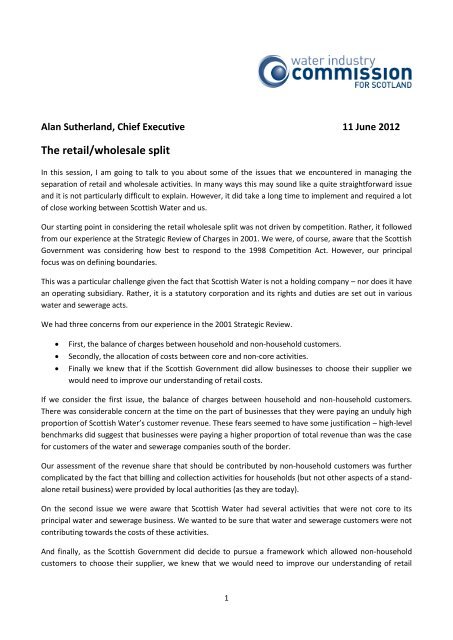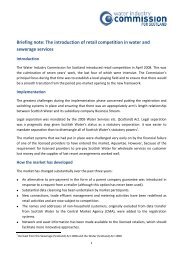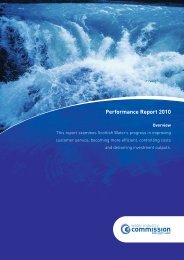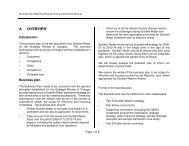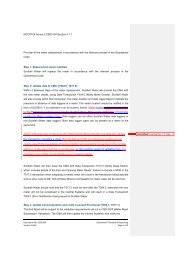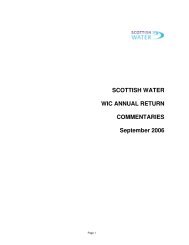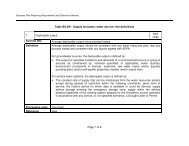The retail/wholesale split - Water Industry Commission for Scotland
The retail/wholesale split - Water Industry Commission for Scotland
The retail/wholesale split - Water Industry Commission for Scotland
You also want an ePaper? Increase the reach of your titles
YUMPU automatically turns print PDFs into web optimized ePapers that Google loves.
Alan Sutherland, Chief Executive 11 June 2012<br />
<strong>The</strong> <strong>retail</strong>/<strong>wholesale</strong> <strong>split</strong><br />
In this session, I am going to talk to you about some of the issues that we encountered in managing the<br />
separation of <strong>retail</strong> and <strong>wholesale</strong> activities. In many ways this may sound like a quite straight<strong>for</strong>ward issue<br />
and it is not particularly difficult to explain. However, it did take a long time to implement and required a lot<br />
of close working between Scottish <strong>Water</strong> and us.<br />
Our starting point in considering the <strong>retail</strong> <strong>wholesale</strong> <strong>split</strong> was not driven by competition. Rather, it followed<br />
from our experience at the Strategic Review of Charges in 2001. We were, of course, aware that the Scottish<br />
Government was considering how best to respond to the 1998 Competition Act. However, our principal<br />
focus was on defining boundaries.<br />
This was a particular challenge given the fact that Scottish <strong>Water</strong> is not a holding company – nor does it have<br />
an operating subsidiary. Rather, it is a statutory corporation and its rights and duties are set out in various<br />
water and sewerage acts.<br />
We had three concerns from our experience in the 2001 Strategic Review.<br />
<br />
<br />
<br />
First, the balance of charges between household and non-household customers.<br />
Secondly, the allocation of costs between core and non-core activities.<br />
Finally we knew that if the Scottish Government did allow businesses to choose their supplier we<br />
would need to improve our understanding of <strong>retail</strong> costs.<br />
If we consider the first issue, the balance of charges between household and non-household customers.<br />
<strong>The</strong>re was considerable concern at the time on the part of businesses that they were paying an unduly high<br />
proportion of Scottish <strong>Water</strong>’s customer revenue. <strong>The</strong>se fears seemed to have some justification – high-level<br />
benchmarks did suggest that businesses were paying a higher proportion of total revenue than was the case<br />
<strong>for</strong> customers of the water and sewerage companies south of the border.<br />
Our assessment of the revenue share that should be contributed by non-household customers was further<br />
complicated by the fact that billing and collection activities <strong>for</strong> households (but not other aspects of a standalone<br />
<strong>retail</strong> business) were provided by local authorities (as they are today).<br />
On the second issue we were aware that Scottish <strong>Water</strong> had several activities that were not core to its<br />
principal water and sewerage business. We wanted to be sure that water and sewerage customers were not<br />
contributing towards the costs of these activities.<br />
And finally, as the Scottish Government did decide to pursue a framework which allowed non-household<br />
customers to choose their supplier, we knew that we would need to improve our understanding of <strong>retail</strong><br />
1
costs. New entrants were at the time quite active at offering on-site services to some of the larger users of<br />
water and waste water services and seemed likely to challenge any potential misallocation of costs.<br />
So, to address these issues, and following the 2001 Strategic Review, we undertook initial work to define the<br />
boundaries between <strong>wholesale</strong> and <strong>retail</strong> activities and between core and non-core activities. This was<br />
included in the guidance and tables we issued to Scottish <strong>Water</strong> <strong>for</strong> its Annual Return <strong>for</strong> 2003-04. Our work<br />
drew on a number of different strands:<br />
We undertook a review of Ofwat’s Regulatory Accounting Guidelines whereby we tested the extent to which<br />
they could be applied to the water industry in <strong>Scotland</strong>. This included proposals (which in the event we did<br />
not pursue) to collect the costs of different functions in the water and sewerage value chain.<br />
<br />
<br />
<br />
We held preliminary discussions with Scottish <strong>Water</strong> to identify core and non-core functions, based<br />
on the legal definition provided by the <strong>Water</strong> <strong>Industry</strong> (<strong>Scotland</strong>) Act 2002.<br />
We developed two draft regulatory accounting tables to capture operating costs <strong>for</strong> core functions,<br />
separated into <strong>wholesale</strong> and <strong>retail</strong> activities.<br />
And we issued Scottish <strong>Water</strong> with draft tables <strong>for</strong> operating costs <strong>for</strong> it to comment on and<br />
complete with in<strong>for</strong>mation <strong>for</strong> 2003-04.<br />
We recognized that the introduction of robust accounting separation and regulatory accounts would require<br />
significant cooperation from Scottish <strong>Water</strong>, although at the time we had a really quite adversarial<br />
relationship. It was important there<strong>for</strong>e that we explained carefully the scope of the in<strong>for</strong>mation that we<br />
planned to collect, and the use that we would make of the in<strong>for</strong>mation. We were also careful to seek<br />
Scottish <strong>Water</strong>’s views on how best to collect the in<strong>for</strong>mation.<br />
This was particularly important as we wanted to be sure that we collected all of the cost in<strong>for</strong>mation<br />
allocated by Scottish <strong>Water</strong> to each activity and that the total activity costs allocated reconciled with the<br />
overall level of reported costs. Even at this early stage it was important to ensure that the definitions of<br />
activities would allow us to avoid gaps, overlaps or avoidable uncertainties in the reported in<strong>for</strong>mation.<br />
Scottish <strong>Water</strong> was supportive throughout this exercise, which we were grateful <strong>for</strong> and meant that the<br />
necessary work could be done.<br />
Scottish <strong>Water</strong> had begun to introduce an activity based costing system and so already understood many of<br />
its costs at a detailed sub-asset level. This meant that the company could respond well and quickly to our<br />
in<strong>for</strong>mation requests. For our part, wherever possible, we tailored our definitions of each activity to align<br />
with the ‘data dictionary’ that underpinned Scottish <strong>Water</strong>’s activity based costing system.<br />
By summer 2004 we were in a position to build on our preparatory work and to develop the regulatory<br />
accounts project further. To help we contracted Ernst and Young LLP and Black and Veatch Consulting to use<br />
their respective accounting and reporting expertise to deliver the following key objectives:<br />
<br />
<br />
<br />
To identify and define the core and non-core businesses carried out by Scottish <strong>Water</strong>.<br />
To identify and define the <strong>retail</strong> and <strong>wholesale</strong> segments of the core business and to provide<br />
separate reporting frameworks <strong>for</strong> these activities.<br />
To design a series of reports and in<strong>for</strong>mation tables, which would allow us to understand and<br />
analyse the <strong>retail</strong> and <strong>wholesale</strong> segments of the core water and sewerage industry.<br />
2
To develop a set of regulatory accounting guidelines, which explained our objectives and defined the<br />
nature of the in<strong>for</strong>mation required.<br />
We used the regulatory accounts, as finalized in our joint work with Ernst and Young, to define <strong>retail</strong> and<br />
<strong>wholesale</strong> activities in detail.<br />
Defining <strong>retail</strong> and <strong>wholesale</strong> activities at a relatively high level is fairly straight<strong>for</strong>ward:<br />
<br />
<br />
Retail is the selling of goods or services directly to consumers; it is usually in small quantities and the<br />
goods or services are not <strong>for</strong> resale.<br />
Wholesale is the selling of goods or services to merchants, usually in large quantities and <strong>for</strong> resale<br />
to consumers.<br />
Many markets make a distinction between <strong>wholesale</strong> and <strong>retail</strong> activities. Retailers specialise in knowing and<br />
understanding customers: what they want to buy and how they would like it to be provided. <strong>The</strong>y benefit<br />
from economies of scale by buying the product <strong>wholesale</strong>, and from economies of scope by selling the<br />
products and services of different suppliers to their customers. So, we took this to be a single guiding<br />
definition.<br />
Ernst & Young facilitated a series of workshops involving Scottish <strong>Water</strong>, the Scottish Government and us.<br />
<strong>The</strong> aim was to allow us to reach a consensus about activities that were <strong>retail</strong> and those that were<br />
<strong>wholesale</strong>. At the start of this process, we agreed that the <strong>retail</strong> activity would have to be capable of being a<br />
stand-alone business, capable of operating at arm’s length from Scottish <strong>Water</strong>. A further initial factor was<br />
the desire to reduce the risk of a new entrant referring the new framework and the <strong>split</strong> of <strong>retail</strong> and<br />
<strong>wholesale</strong> activities to the Office of Fair Trading.<br />
It proved relatively straight<strong>for</strong>ward to agree most of the <strong>retail</strong> activities, and we identified the following:<br />
<br />
<br />
<br />
<br />
<br />
<br />
<br />
<br />
<br />
<br />
<br />
<br />
<br />
<strong>retail</strong> pricing and tariffs;<br />
the billing process;<br />
collection of charges;<br />
debt follow up and debt management;<br />
meter reading and customer meter operations;<br />
call and correspondence handling;<br />
responses to customer enquiries, complaints or requests <strong>for</strong> in<strong>for</strong>mation;<br />
key account management;<br />
liaison with the <strong>wholesale</strong>r to deal with customer issues;<br />
marketing;<br />
managing the connection/disconnection process;<br />
scheduling septic tank emptying; and<br />
supporting <strong>wholesale</strong> emergency responses.<br />
Many of these activities are clear cut and would make any definition of <strong>retail</strong>. Others could potentially be<br />
allocated to either the <strong>wholesale</strong> or the <strong>retail</strong> business. For example, there was some debate about meter<br />
ownership, operational calls and connections. In the event however we were able to resolve these issues<br />
fairly easily.<br />
3
It became obvious that transferring the ownership of meters would be problematic – should they be owned<br />
by the customer or the <strong>retail</strong>er If the latter option were chosen, the <strong>retail</strong>er would need additional capital<br />
and there would be a need to value the meter and allow <strong>for</strong> the sale of the meter every time a customer<br />
chose to switch supply.<br />
<strong>The</strong> alternative option of customer ownership did have some superficial attractions but there was general<br />
agreement among all stakeholders that businesses should, wherever practical, be metered. Who would pay<br />
<strong>for</strong> the new meters or <strong>for</strong> replacing meters that were coming to the end of their lives In actual fact, it was a<br />
much more mundane issue that resolved the fate of meter ownership: property rates. It became clear that<br />
separating the ownership of the meter from Scottish <strong>Water</strong>’s network would lead to additional rates<br />
becoming payable (the meter would be allocated a rateable value in its own right and the owner would have<br />
to pay).<br />
In considering the issue of operational calls and connections, we debated whether it was possible that a new<br />
entrant or a self-supply licensee could want to take responsibility <strong>for</strong> the activity. In both cases, we<br />
concluded that it was conceivable and there<strong>for</strong>e the activity was allocated to <strong>retail</strong>.<br />
More generally, we concluded that a new <strong>retail</strong>er could want to take responsibility <strong>for</strong> all customer-facing<br />
activities. In this model, a non-household customer only interacts with their <strong>retail</strong>er. This is similar to the<br />
situation in most other industries. A customer would not, <strong>for</strong> example, seek to return a faulty garment to the<br />
<strong>wholesale</strong>r or to the factory where it was made.<br />
We also recognized that this approach was quite different from the design of the supply/distribution<br />
business separation in the energy sector. <strong>The</strong>re was a school of thought that we should – I have to say I<br />
thought rather blindly – simply pursue the same route. We did not find that option attractive as there<br />
appeared to be some customer concern about when and who to contact in the event of a problem. A small<br />
business owner, <strong>for</strong> example, made the point to us that he could not hold a network operator responsible<br />
<strong>for</strong> promises if he had no direct commercial relationship with that operator.<br />
<strong>The</strong> advantage of using our single definition of the <strong>wholesale</strong>/<strong>retail</strong> <strong>split</strong> is that it kept things simple when we<br />
came to calculate the overall <strong>retail</strong> margin and because the charges we determined <strong>for</strong> <strong>wholesale</strong> services<br />
covered a clearly defined set of activities.<br />
In the same way, any <strong>retail</strong>er would know the single defined gross margin between <strong>retail</strong> charges and the<br />
<strong>wholesale</strong> charges covering all of the activities <strong>for</strong> which he would be taking responsibility.<br />
We recognized too that some new entrants would not want to take responsibility <strong>for</strong> all of the <strong>retail</strong><br />
activities. For this reason we allowed a <strong>retail</strong>er to contract third parties (including Scottish <strong>Water</strong>) to deliver<br />
<strong>retail</strong> activities on their behalf. Importantly, however, in these cases we made sure that the <strong>retail</strong>er retains<br />
responsibility <strong>for</strong> ensuring that the activity is actually delivered.<br />
Defining activities and assets as being <strong>retail</strong> and <strong>wholesale</strong> was the easy bit of designing the <strong>retail</strong>/<strong>wholesale</strong><br />
separation. <strong>The</strong> three main problematical issues included:<br />
<br />
<br />
<br />
deciding who should be responsible <strong>for</strong> bad debt,<br />
allocating working capital, and<br />
determining the cost of capital and the capital structure of a <strong>retail</strong> activity.<br />
4
I will now deal with each of these in turn.<br />
In relation to bad debt, a case could be made in favour of bad debt being allocated to the <strong>wholesale</strong><br />
business. <strong>The</strong> <strong>wholesale</strong> business has a lower cost of capital and its revenues are much higher than those of<br />
the <strong>retail</strong>er; potential losses from non-payment are also much less significant.<br />
However, if <strong>retail</strong>ers are not responsible <strong>for</strong> bad debt, there would be little, if any, incentive on the <strong>retail</strong>er<br />
to try very hard to collect money owed by customers. How would the <strong>wholesale</strong>r recover the losses, or<br />
would these simply be spread over other customers<br />
<strong>The</strong> second issue, the allocation of the working capital of a vertically integrated water company, is not<br />
straight<strong>for</strong>ward. <strong>The</strong>re are customer pre-payments and debts; there are the normal supplier relationships;<br />
and there are the monies owed to contractors.<br />
Our first step was to identify the net working capital position in billing with customers. It was also necessary<br />
to understand any pre-payments or monies that suppliers of products or services owed directly to the <strong>retail</strong><br />
activities of the water company. Finally we had to consider the <strong>retail</strong>er’s share of any pre-payments or<br />
monies owed by the vertically integrated company.<br />
This exercise should reveal the share of the working capital that could appropriately be allocated to the <strong>retail</strong><br />
activity. However, this assumes that both the <strong>wholesale</strong> and the <strong>retail</strong> businesses are happy to continue with<br />
the working capital arrangements that may well be perfectly adequate <strong>for</strong> the vertically integrated company<br />
as a whole. If not the allocation of revised working capital is likely to be even more complicated.<br />
If the <strong>wholesale</strong> business were to be owed substantial amounts by customers, there is a risk – similar to that<br />
relating to bad debt – that the <strong>wholesale</strong>r has an exposure to credit risk which it can do nothing about.<br />
We looked at a range of options to ensure that the <strong>retail</strong>ers were credit-worthy – in the end we considered<br />
that it was best to ask <strong>retail</strong>ers to pre-pay the <strong>wholesale</strong>rs. <strong>The</strong>re were several reasons <strong>for</strong> this:<br />
<br />
<br />
<br />
the difficulty of assessing credit-worthiness (both on a one-off and an on-going basis), particularly<br />
<strong>for</strong> smaller potential new entrants or <strong>for</strong> start-up companies that wanted to enter the market;<br />
the cost of maintaining checks on credit-worthiness;<br />
a desire to avoid creating the temptation <strong>for</strong> the incumbent to discriminate on a non-price basis<br />
against particular new entrants (possible where the customer has a much higher credit-worthiness<br />
relative to the <strong>retail</strong>er). This could act to the detriment of the customer as it could result in less<br />
effective choice.<br />
As we did not want the <strong>wholesale</strong>r to take credit risk – when it is not well placed to control it – it is us who<br />
issue the <strong>retail</strong>ers’ licences and set default positions <strong>for</strong> the <strong>wholesale</strong> service agreements.<br />
We also worked out a pre-payment pattern that each <strong>retail</strong>er would have to meet. Retailers pay 45 days<br />
worth of estimated <strong>wholesale</strong> charges. When this balance falls to 15 days of a pre-payment, <strong>retail</strong>ers top it<br />
up with a further 30 days. <strong>The</strong> starting working capital position of Scottish <strong>Water</strong>’s <strong>retail</strong> entity was there<strong>for</strong>e<br />
its net position with end customers (as adjusted by the other flows that I mentioned earlier) and the value of<br />
45 days pre-payment to Scottish <strong>Water</strong>.<br />
5
Turning now to the third of the major issues that we had to address: the cost of capital and the capital<br />
structure of a <strong>retail</strong> activity. We made a clear decision that the RCV would remain wholly within the<br />
<strong>wholesale</strong> business. However, it was clear that some assets were to be transferred to the <strong>retail</strong> subsidiary.<br />
Agreeing the transfer (and the value of the transfer of billing system assets) was probably easier in <strong>Scotland</strong><br />
than it would be in England because Scottish <strong>Water</strong> itself only billed non-household customers and a small<br />
number of metered household customers.<br />
We left it to Scottish <strong>Water</strong> to tell us the value of these assets. We felt that we could do this because of two<br />
important factors:<br />
<br />
<br />
we had made it clear that Scottish <strong>Water</strong>’s <strong>retail</strong> subsidiary would need to earn a minimum<br />
appropriate return (we were determined that no new entrant could claim that Scottish <strong>Water</strong>’s<br />
<strong>retail</strong> subsidiary was engaging in predatory pricing); and<br />
because of the tension that existed between that part of Scottish <strong>Water</strong> that would become the<br />
<strong>wholesale</strong> business and the part that would become the <strong>retail</strong> business.<br />
I remember Claire Spottiswoode telling me about the tensions that quickly appeared within British Gas as it<br />
contemplated a <strong>split</strong> in its activities. Although I was sceptical at the time, similar tensions did appear within<br />
Scottish <strong>Water</strong>.<br />
Scottish <strong>Water</strong>’s business plan suggested that assets with a net book value of £2 million were to be<br />
transferred to its <strong>retail</strong> subsidiary. We assumed that these assets were, in line with the totality of Scottish<br />
<strong>Water</strong> assets, half way through their useful lives. We also assumed that these assets would have, on<br />
average, a six-year life. This led us to allocate a depreciation charge of £0.67 million to the <strong>retail</strong> subsidiary.<br />
In our view, it was reasonable to accept that Scottish <strong>Water</strong>’s <strong>retail</strong> subsidiary would have an increased cost<br />
of capital. We accepted this argument <strong>for</strong> two reasons:<br />
<br />
<br />
In a competitive market, Scottish <strong>Water</strong>’s <strong>retail</strong> subsidiary would enjoy an unfair advantage relative<br />
to new market entrants if it could access capital at public sector rates.<br />
Retail activity in a competitive market is an intrinsically more risky activity than <strong>for</strong> a regulated<br />
natural monopoly.<br />
We commissioned Ernst & Young to advise on an appropriate cost of capital <strong>for</strong> Scottish <strong>Water</strong>’s <strong>retail</strong><br />
subsidiary. Scottish <strong>Water</strong> also submitted useful evidence on the subject from a range of investment banks<br />
including Rothschild and Goldman Sachs. <strong>The</strong>re was broad consensus that a reasonable weighted average<br />
cost of capital (WACC) <strong>for</strong> the new <strong>retail</strong> business could be from 8.2% and 9.4% nominal pre-tax. <strong>The</strong><br />
position in this range depended on the capital structure of the <strong>retail</strong> subsidiary. We accepted a cost of equity<br />
of 12% and a cost of debt of 6%. <strong>The</strong> 8.2% to 9.4% range <strong>for</strong> the WACC compares with the WACC of between<br />
4.1% and 4.2% that we allowed <strong>for</strong> Scottish <strong>Water</strong>’s core business.<br />
Our view on the appropriate cost of capital <strong>for</strong> the <strong>retail</strong> business was influenced by several factors:<br />
Changes in the revenue base: When the market opened to competition, Scottish <strong>Water</strong>’s <strong>retail</strong> subsidiary<br />
had 100% of the available non-household customers. We recognised that it would inevitably lose customers<br />
over time. As a result, we considered that we had to allow it the space to develop a cost structure that<br />
would be sufficiently flexible to adapt to the level of revenue it could retain.<br />
6
A very thin margin: Our decisions on the level of <strong>retail</strong> and <strong>wholesale</strong> price caps allowed only a relatively<br />
small margin, even <strong>for</strong> a successful <strong>retail</strong>er. We expected that it would come under pressure to offer<br />
discounts and that it may have to offer improved levels of service. (As you may have heard me say be<strong>for</strong>e, I<br />
was wrong about the relative pressure to discount versus pressure to offer improved or more tailored levels<br />
of service – the most important pressure has clearly been the latter.) We recognised that the supply of utility<br />
services was a very low margin business even if the internal rate of return on invested capital was potentially<br />
very high. We were keen to ensure that Scottish <strong>Water</strong>’s <strong>retail</strong> subsidiary faced a clear pressure to reduce its<br />
costs but that it did not have any excuses.<br />
Capital structure: Based on our own review of the evidence and the advice available from Ernst and Young,<br />
we concluded that the core (non- working capital) funding of the <strong>retail</strong> subsidiary should be equity. We also<br />
concluded that a proportion of the working capital should be funded by equity.<br />
We there<strong>for</strong>e concluded that the allowed return (in cash terms) of Scottish <strong>Water</strong>’s <strong>retail</strong> subsidiary should<br />
be made up as follows:<br />
An equity return on the net book value of the assets to be transferred (ie the £2 million outlined earlier).<br />
<br />
<br />
<br />
A starting working capital transferred to the <strong>retail</strong> subsidiary of £88.20 million. This was taken from<br />
Scottish <strong>Water</strong>’s <strong>retail</strong> business plan and checked against our own observation of the working capital<br />
position of the vertically integrated company.<br />
A bank facility <strong>for</strong> working capital to cover 80% of working capital requirements, with the remaining<br />
20% to be financed from equity in the <strong>retail</strong> subsidiary.<br />
We further assumed that the debt costs associated with the working capital should be 6% (at the<br />
time LIBOR plus 1%). This was in line with the advice we had received on the costs of funding the<br />
<strong>retail</strong> subsidiary of Scottish <strong>Water</strong>.<br />
<strong>The</strong> cash cost of capital of Scottish <strong>Water</strong>’s <strong>retail</strong> subsidiary was £6.6 million. <strong>The</strong> cost of capital if these<br />
activities had been retained within the core business and funded by debt would have been £4.2 million. <strong>The</strong><br />
extra cost that had to be met by the <strong>retail</strong> subsidiary was there<strong>for</strong>e £2.4 million.<br />
We considered it reasonable to expect that the new <strong>retail</strong> subsidiary of Scottish <strong>Water</strong> would be likely to pay<br />
corporation tax. We made some simplifying assumptions:<br />
<br />
<br />
that the capital allowances available to the <strong>retail</strong> subsidiary <strong>for</strong> tax purposes were broadly equal to<br />
the depreciation charge;<br />
that the <strong>retail</strong> subsidiary generates a post-tax, post-dividend profit of £0.00 million; and<br />
that the tax rate was 30%.<br />
Our analysis suggested that there would be an increase of £0.50 million from what would have been payable<br />
in each year had the subsidiary not been established.<br />
<strong>The</strong>re were, of course, other new costs that Scottish <strong>Water</strong> rightly claimed <strong>for</strong> its new <strong>retail</strong> subsidiary. But<br />
not all of the claims were valid. We will now go through these and our reasoning at the time. Given that<br />
costs have fallen substantially since, we were, if anything, generous – but this was in keeping with the<br />
imperative of avoiding a challenge under Competition Law.<br />
7
This cost allocation exercise was being run in parallel with and as a part of the price determination process.<br />
<strong>The</strong>re was considerable joint working on cost allocations. But the price review process then took over!<br />
As we expected Scottish <strong>Water</strong> claimed some additional new costs both <strong>for</strong> its <strong>wholesale</strong> business and <strong>for</strong> its<br />
<strong>retail</strong> business. We considered some of these claims to be reasonable and accepted them in full or in part.<br />
Perhaps inevitably, some of the claims, in our view, did not have merit so were rejected.<br />
In its second draft business plan <strong>for</strong> the <strong>retail</strong> business, Scottish <strong>Water</strong> set out its views on these extra costs.<br />
<strong>The</strong> claims divided into set-up costs and on-going costs.<br />
Set-up costs included:<br />
<br />
<br />
<br />
<br />
<br />
<br />
restructuring<br />
internal preparation<br />
IT separation<br />
the <strong>retail</strong> contact management system<br />
additional capital expenditure to maintain new systems, and<br />
a contribution to developing market structures.<br />
Scottish <strong>Water</strong>’s business plan claimed just under £1 million in both 2008-09 and 2009-10 <strong>for</strong> restructuring<br />
costs within its <strong>retail</strong> business. We disallowed this claim since we considered it inappropriate to allow<br />
restructuring costs <strong>for</strong> a <strong>retail</strong> business that would be subject to competition and would benefit from a<br />
commercial rate of return.<br />
This is not to say that we did not recognise that businesses have to adapt to changing conditions in their<br />
market place. And we also agreed that Scottish <strong>Water</strong>’s <strong>retail</strong> subsidiary would have to contend with a<br />
declining number of customers and would need to ensure that its cost base was in line with its share of the<br />
<strong>retail</strong> market. However, we did not wish to encourage restructuring costs to be incurred that did not also<br />
lower the costs of the business.<br />
Scottish <strong>Water</strong> also claimed set-up costs associated with preparing <strong>for</strong> life in a competitive framework,<br />
including:<br />
<br />
<br />
<br />
<br />
establishing management and reporting structures;<br />
developing contracts with business customers and Scottish <strong>Water</strong>;<br />
establishing legal and financial structures; and<br />
communicating with staff and customers.<br />
Many of these costs had been incurred be<strong>for</strong>e the business plan was written. We allowed these costs <strong>for</strong><br />
2005-06 and 2006-07.<br />
Scottish <strong>Water</strong>’s business plan included costs <strong>for</strong> separating billing and customer contact management<br />
systems, transferring the current billing system and adding further functionality. We allowed this claim of<br />
£7.25 million but allowed it only pre-efficiency in line with the scope <strong>for</strong> efficiency that we found in the<br />
wider capital programme.<br />
Scottish <strong>Water</strong> considered that additional capital expenditure was necessary to cover the separation of<br />
underlying IT systems and to produce a copy of the contact management system and database. We<br />
8
considered this claim to be without merit as it appeared to have been included in the allowed <strong>for</strong> IT<br />
separation costs already.<br />
Scottish <strong>Water</strong>’s business plan also claimed additional capital expenditure to maintain new systems. We<br />
allowed this claim but, again, assumed that the general efficiency challenge to capital expenditure should<br />
apply. We allowed just over £0.1 million post-efficiency.<br />
Scottish <strong>Water</strong>’s business plan identified additional costs to cover its <strong>retail</strong> arm’s contribution to the<br />
development of market mechanisms. We assumed that all of these costs would fall on Scottish <strong>Water</strong>’s<br />
<strong>wholesale</strong> business and made no allowance <strong>for</strong> such costs in the <strong>retail</strong> business.<br />
Given the uncertainty around the costs that would be incurred in separating <strong>retail</strong> and <strong>wholesale</strong> activities,<br />
we considered it appropriate to make an additional £130,000 available to the <strong>retail</strong> business in each year as<br />
a contingency.<br />
In summary, we allowed set-up costs of just under £6.3 million in 2006-07 and £250K each year afterwards.<br />
We assumed that these additions to the asset base should be financed by equity and that they should be<br />
fully depreciated over five years.<br />
Scottish <strong>Water</strong> also made a number of claims <strong>for</strong> increased annual operating costs. <strong>The</strong> claims included:<br />
<br />
<br />
<br />
<br />
<br />
<br />
<br />
<br />
<br />
interface with market mechanisms<br />
development and operation of market mechanisms<br />
additional customer management ef<strong>for</strong>t<br />
additional costs in <strong>retail</strong> contact management centre due to separation<br />
managing the relationship with the <strong>wholesale</strong> business<br />
additional marketing ef<strong>for</strong>ts<br />
contribution to the costs of WICS<br />
operating costs <strong>for</strong> newly metered customers, and<br />
new costs from IT separation.<br />
Scottish <strong>Water</strong>’s <strong>retail</strong> subsidiary’s business plan explained that there would be new costs associated with<br />
the interface with market mechanisms. We accepted that there may be a small additional cost (£0.20<br />
million) and allowed the claim.<br />
We allowed the <strong>retail</strong> subsidiary’s claim <strong>for</strong> its contribution to developing and operating the market. We<br />
were clear that we envisaged a simple customer registration system that should have operating costs<br />
(including depreciation) that were no more than £2.50 million per year. <strong>The</strong> original claim was <strong>for</strong> £4.2<br />
million a year.<br />
<strong>The</strong> <strong>retail</strong> subsidiary’s business plan stated that costs would be incurred in enhancing customer service so as<br />
not to lose market share in a competitive environment. Perhaps not surprisingly, we were not persuaded<br />
that the <strong>retail</strong> subsidiary should incur extra costs in managing its non-household customers as a result of the<br />
introduction of the competition framework. In our view it should be <strong>for</strong> the market to determine whether an<br />
enhanced level of <strong>retail</strong> service at extra cost was appropriate. We did not accept this claim of nearly £0.5<br />
million a year.<br />
9
On a similar note, Scottish <strong>Water</strong>’s <strong>retail</strong> subsidiary expected to incur higher unit costs in serving customers<br />
in the following functions due to the separation of activities:<br />
<br />
<br />
<br />
<br />
<br />
key customer management/strategic liaison;<br />
business and community relations;<br />
marketing;<br />
customer operations; and<br />
a customer support group.<br />
We were again not persuaded that the <strong>retail</strong> subsidiary should incur extra costs in managing its nonhousehold<br />
customers as a result of the introduction of the competitive framework. In our view,<br />
management is responsible <strong>for</strong> ensuring that its cost base is sufficiently flexible to respond effectively to the<br />
loss or regaining of customers in a competitive market. We there<strong>for</strong>e did not accept this claim.<br />
Scottish <strong>Water</strong>’s <strong>retail</strong> subsidiary also claimed additional costs in its <strong>retail</strong> contact management centre due<br />
to separation. <strong>The</strong>se costs covered services that would previously have been carried out by the household<br />
contacts team. <strong>The</strong>y include handling operational business contacts and ‘out of hours’ emergency situations.<br />
In addition, they included the loss of scale and scope economies in the customer management centre.<br />
We accepted that some additional initial costs may be incurred in the contact management centre as a result<br />
of the separation. However, we believed this was within the control of management to address. We allowed<br />
£0.30 million in the first year and reduced it to zero by the end of the regulatory control period.<br />
Scottish <strong>Water</strong> also claimed costs associated with regulation and licensing, additional management<br />
structures and relations with the core business. <strong>The</strong> business plan details these costs as covering:<br />
<br />
<br />
<br />
<br />
a separate board and management team;<br />
monitoring compliance with the separation regime;<br />
additional reporting requirements to the <strong>Commission</strong>; and<br />
contractual relations with the <strong>wholesale</strong> business.<br />
We recognised that this claim had some merit although it did appear to be somewhat higher than could be<br />
justified. We assumed that a team of three people would be appointed to deal with these issues. Our<br />
allowance was £0.2 million <strong>for</strong> each year of the regulatory control period.<br />
Scottish <strong>Water</strong>’s business plan pointed out the additional marketing pressures that its <strong>retail</strong> subsidiary was<br />
likely to face in a competitive market. We accepted this claim since we agreed that there would be new<br />
pressures to retain and win back customers.<br />
Scottish <strong>Water</strong>’s business plan made a claim <strong>for</strong> its contribution towards the additional costs of the (then)<br />
new <strong>Water</strong> <strong>Industry</strong> <strong>Commission</strong> in policing the new market framework.<br />
However we only allowed the claim from 2008-09 because the Scottish Government had made it clear that<br />
the <strong>Commission</strong>’s costs in developing the licensing regime would be covered by grant-in-aid until market<br />
opening in April 2008.<br />
10
In line with Government policy, Scottish <strong>Water</strong> planned to increase the number of metered customers. It<br />
was not unreasonable that Scottish <strong>Water</strong> should claim <strong>for</strong> the operating costs arising from newly metered<br />
customers.<br />
Scottish <strong>Water</strong> considered that its <strong>retail</strong> arm would incur one-off operational costs as a result of IT<br />
separation. We did not accept that additional costs should arise due to the separation of the IT system and<br />
considered that such costs were fully within the control of management.<br />
In summary we allowed additional operating costs of about £700K a year prior to market opening and about<br />
£3.5 million a year in the years after market opening. Each of these allowances was subject to the same<br />
operating cost efficiency challenge that we applied to other operating costs.<br />
I will close this section of the workshop with some short comments on the importance of transfer pricing.<br />
We considered that this was important even where Scottish <strong>Water</strong> had opted to establish its own <strong>retail</strong><br />
subsidiary. No doubt if Scottish <strong>Water</strong> had decided to separate but without establishing a separate legal<br />
entity we would have paid even more attention to potential issues arising from transfer pricing.<br />
Ensuring that transfer prices are appropriate was, in our view, essential to ensuring that there could be no<br />
undue cross subsidy. We were and remain of the view that transfer prices should, wherever possible, be<br />
based on a market price <strong>for</strong> the service provided.<br />
At the time we explained that if Scottish <strong>Water</strong> outsourced some of its activities (<strong>for</strong> example household<br />
meter reading) to its <strong>retail</strong> subsidiary and paid a price higher than the cost of providing the service, then<br />
household customers could end up effectively subsidizing the operations of the <strong>retail</strong> subsidiary and face<br />
higher bills as a result.<br />
This brings me to the end of this session. I have talked about how we defined <strong>retail</strong>/<strong>wholesale</strong> activities, the<br />
key issues we had to overcome (bad debt etc) and our approach to other additional costs as a result of the<br />
separation.<br />
After lunch we will look at setting charge caps…<br />
11


